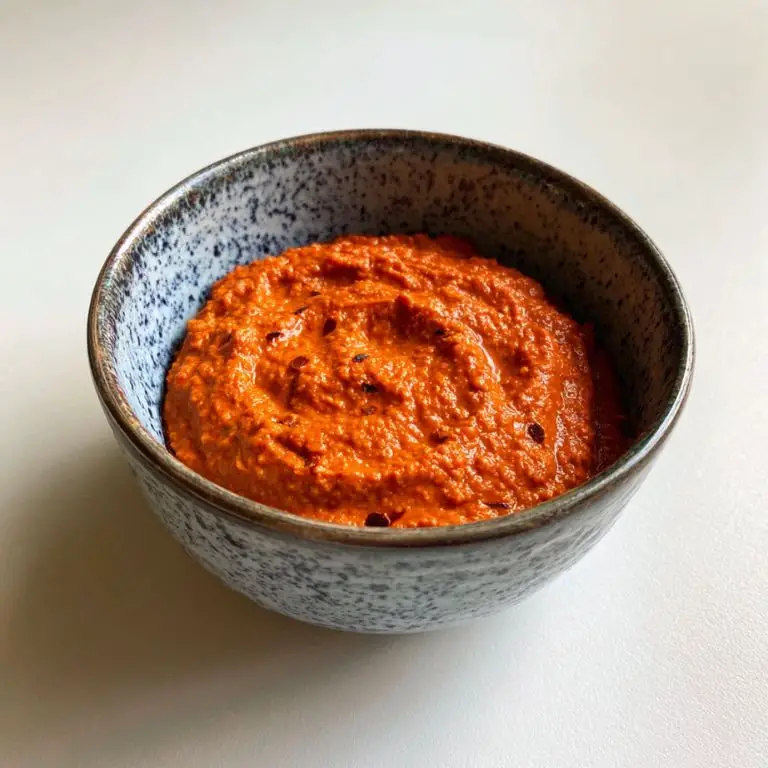If you’ve been missing the smoky, spicy depth of traditional 'nduja since going plant-based, you’re not alone. This vegan nduja with walnuts and miso brings the same umami-rich punch—minus the meat. A riff on Calabrian ‘nduja, this spreadable, fiery condiment has been reimagined using walnuts, roasted red peppers, miso, and aubergine. It’s the kind of savory, versatile vegan spread that could easily find its way into your regular rotation. Whether you’re looking to elevate your brunch spread or add depth to pasta sauces and stews, this is one of those vegan Italian recipes that over-delivers. It also happens to be one of the easiest gourmet vegan recipes to whip up in under an hour.
Vegan Nduja with Walnuts and Miso for a Savory Punch
Prep Time 15 minutes mins
Cook Time 30 minutes mins
Total Time 45 minutes mins
Course Appetizer, Condiment, Snack
Cuisine Italian, Japanese
Servings 1.5 cups (about 4–6 servings)
Oven for roasting the aubergine (you can also use a grill or broiler)
Food Processor or High-Speed Blender essential for achieving that creamy, spreadable consistency
Sheet pan to roast the aubergine
Skillet (optional) if you want to toast your walnuts yourself instead of buying pre-toasted
Spatula or spoon to scrape down the sides while blending
- 1 large aubergine eggplant, roasted (about 300g flesh)
- 1 cup walnuts toasted
- 2 tablespoons white miso paste
- 2 roasted red peppers jarred or homemade
- 1 tablespoon tomato paste
- 2 tablespoons olive oil
- 1 tablespoon smoked paprika
- 1 teaspoon chili flakes adjust to taste
- 1 teaspoon garlic powder
- 1 tablespoon red wine vinegar
- 1/2 teaspoon salt or to taste
- Black pepper to taste
- Water or olive oil to adjust texture if needed
Roast the Aubergine
Start by preheating your oven to 400°F (200°C). Prick the aubergine a few times with a fork and place it on a lined sheet pan. Roast for about 30 minutes, or until the skin is blistered and the inside is buttery-soft. Let it cool slightly, then scoop out the flesh and discard the skin.
Note: Roasting the aubergine gives a soft, smoky flavor that’s key in many vegan aubergine recipes, and it mimics the richness of traditional meat-based spreads.
Toast the Walnuts
While the aubergine is roasting, toast the walnuts in a dry skillet over medium heat for 3–5 minutes, or until fragrant. Let them cool slightly. Toasting enhances their natural oils, deepening the flavor and giving more body to the final spread.
Blend the Ingredients
Add the aubergine flesh, toasted walnuts, miso paste, roasted red peppers, tomato paste, olive oil, smoked paprika, chili flakes, garlic powder, red wine vinegar, salt, and black pepper into your food processor.
Blend on high until smooth and creamy. Stop occasionally to scrape down the sides. If the mixture is too thick, add a splash of water or olive oil to loosen it to your desired consistency.
Taste and Adjust
Give it a taste. Want it smokier? Add a touch more paprika. Spicier? Toss in extra chili flakes. Tangier? More vinegar. The beauty of this vegan nduja recipe is how customizable it is.
Store and Serve
Transfer to a jar or airtight container. It can be used immediately but tastes even better after a few hours in the fridge. The flavors meld beautifully, and the umami intensifies.
Pairings
One of the best things about this vegan nduja is its versatility. Think of it less as a dip and more like a flavor bomb you can deploy across meals. Here’s how to make it shine:
- Nduja pasta: Stir a generous spoonful into hot pasta along with a splash of pasta water for a smoky, spicy sauce. Finish with fresh basil and a drizzle of olive oil. It's one of those recipes with nduja that rivals the traditional meat-based versions.
- Toasts and brunch platters: Spread on sourdough or baguette slices, then top with avocado, grilled mushrooms, or even vegan feta. A standout among brunch ideas, especially when paired with a crisp green salad or roasted tomatoes.
- Stuffed veggies: Use as a stuffing base for mushrooms, bell peppers, or zucchini. A great twist on classic recipes using nduja.
- As a sauce: Thin it out with water, oil, or a bit of vegetable broth to turn it into a pasta or grain bowl sauce. Also works as a drizzle for roasted cauliflower or crispy tofu.
- With legumes: Stir into a pot of lentils or chickpeas near the end of cooking for a spicy depth. Try adding it to an eggplant chickpea curry for a bold twist.
FAQs
1. What is nduja, and how does the vegan version compare?
Traditional ‘nduja is a soft, spreadable salami from Calabria, Italy, made with pork, fat, and chili. The vegan version mimics its creamy, spicy, umami-rich flavor using walnuts, miso, and aubergine. While it lacks the meatiness, it hits the same notes and is equally satisfying.
2. Can I make this ahead of time?
Absolutely. In fact, this vegan nduja tastes even better after a day or two in the fridge. The flavors develop and mellow, making it ideal for meal prep or easy dinner recipes.
3. What’s the best type of miso to use?
White miso (shiro miso) is ideal here. It’s slightly sweet and mild, which balances the smoky and spicy components. If you use red miso, reduce the quantity slightly as it can overpower the other ingredients.
4. Can I use other nuts instead of walnuts?
Yes! While walnuts offer the best texture and earthiness for this recipe, almonds or cashews can work in a pinch. Just note that the flavor will be slightly different—less earthy and more buttery.
5. How long does vegan nduja last in the fridge?
Stored in an airtight container, it lasts up to 7 days in the refrigerator. You can also freeze it in small portions to add to future nduja recipe dishes or sauces.
